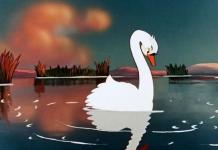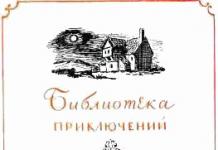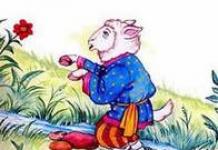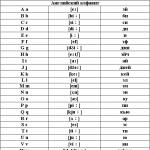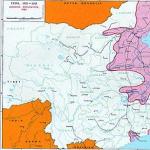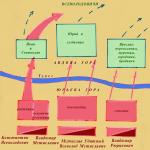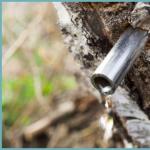The powerful are always to blame for the powerless:
We hear countless examples of this in History,
But we don’t write History;
But this is how they talk about it in Fables.
On a hot day, a lamb went to a stream to drink
And something must happen,
That a hungry Wolf was prowling around those places.
He sees a lamb and strives for the kill;
But, to give the matter at least a legal look and feel,
Shouts: “How dare you, insolent, with an unclean snout
Here's a clean drink
With sand and silt?
For such insolence
I'll rip your head off."
 "When the brightest Wolf allows,
"When the brightest Wolf allows,
I dare say that down the stream
From the Lordship of his steps I drink a hundred;
And he deigns to be angry in vain:
There’s no way I can make him drink worse.”
"That's why I'm lying!
Waste! Such insolence has never been heard of in the world!
Yes, I remember that you were still last summer
Here he was somehow rude to me:
I haven’t forgotten that, buddy!”
“For mercy, I’m not even a year old yet,” -
 The lamb speaks. "So it was your brother."
The lamb speaks. "So it was your brother."
"I have no brothers." - “So this is godfather or matchmaker
Oh, in a word, someone from your own family.
You yourself, your dogs and your shepherds,
You all want me harm
And if you can, then you always harm me,
But I will clear out their sins with you."
"Oh, what is my fault?" - "Be quiet! I'm tired of listening,
It’s time for me to sort through your faults, puppy!
It’s your fault that I want to eat,”
He said and dragged the Lamb into the dark forest.
In 1808, the fable of Ivan Andreevich Krylov (1769-1844) “The Wolf and the Lamb” was first published in the Russian theater magazine “Dramatic Herald”. The fabulist immediately begins with morality, loudly declaring that when the strong and the powerless collide, then in any case the latter will be to blame...
THE WOLF AND THE LAMB
The powerful are always to blame for the powerless:
We hear countless examples of this in History,
But we don’t write History;
But this is how they talk about it in Fables.
***
On a hot day, a lamb went to a stream to drink;
And something must happen,
That a hungry Wolf was prowling around those places.
He sees a lamb and strives for the prey;
But, to give the matter at least a legal look and feel,
Shouts: “How dare you, insolent, with an unclean snout
Here is a clean drink
My
With sand and silt?
For such insolence
I'll rip your head off." —
“When the brightest Wolf allows,
I dare to convey: what’s down the stream
From the Lordship of his steps I drink a hundred;
And he deigns to be angry in vain:
There’s no way I can make him drink worse.” —
“That's why I'm lying!
Waste! Never heard of such insolence in the world!
Yes, I remember that you were last summer
Here he was somehow rude to me:
I haven’t forgotten this, buddy!” —
“For mercy, I’m not even a year old yet,”
The lamb speaks. "So it was your brother." —
"I have no brothers." - “So this is godfather or matchmaker
And, in a word, someone from your own family.
You yourself, your dogs and your shepherds,
You all want me harm
And if you can, then you always harm me,
But I will clear out their sins with you.” —
“Oh, what’s my fault?” - “Be quiet! I'm tired of listening
It’s time for me to sort through your faults, puppy!
It’s your fault that I want to eat.”
He said - and dragged the Lamb into the dark forest.
Picture - shapeshifter “The Wolf and the Lamb”
A fable is a short satirical poem in which certain vices of society are ridiculed and criticized in an allegorical form. The founder of the genre is considered to be the Greek slave Aesop. It was he, unable, due to his dependent position, to directly express to the offenders’ faces everything he wanted, and came up with the idea of expressing his attitude towards certain people, their actions, and character traits in a veiled form. The traditions of Aesop were continued by the French poet La Fontaine, and the Moldavian ones by Dmitry and Antioch Cantemir. And in Russian literature they were developed and raised to a new height by A.P. Sumarokov and I.A. Krylov.
Fable “The Wolf and the Lamb”, Krylov and Aesop
Your fable " The Wolf and the Lamb“Krylov wrote based on a plot invented by Aesop. In this way, he creatively reworked more than one well-known story, creating on its basis an original, original work. Aesop's story goes like this: a lamb drank water from a river. A wolf saw him and decided to eat him. But I tried to choose a more decent excuse. At first, the wolf reproached the baby for muddying the water - he must not drink! The lamb made an excuse by saying that he barely wets his lips, and that he was downstream from the wolf. Then the predator accused his opponent of desecrating his – the wolf – father. But even then the lamb found something to answer: he was not even a year old, due to his age he could not do this. The wolf is tired of putting on a mask of decency. He stated openly: no matter how cleverly you make excuses, I’ll eat it anyway! The moral of the story is obvious: no matter how hard you try to prove your innocence, the better you do it, the less likely you are to win. Of course, if the enemy decided your fate in advance. Aesop's virtue turns out to be not triumphant, but defeated.
Fable " The Wolf and the Lamb“Krylov wrote in 1808, it was published in the Dramatic Bulletin. And its author began immediately with morality, that is, the logical conclusion that readers should have come to by the end of their acquaintance with the text: “For the strong, the powerless are always to blame...”. So that his “Wolf and the Lamb” does not turn out to be unfounded, Krylov relies on historical perspectives, emphasizing that there are “dark examples” of this principle. But in the following lines he contrasts what he said with his own attitude: “...we don’t write history.” It turns out that the fable is a manifestation of an individual case. And generally accepted postulates are tested precisely by such specific cases.
Artistic Features
Krylov's fable “The Wolf and the Lamb” is an epic work. This can be seen, for example, in the following detail: the author’s position can be clearly seen from the very beginning of the fable. But instead of the direct “I”, Krylov uses the generalized “we”. The technique of detachment makes it possible to depict internal space objectively. In general, the entire poem is quite realistic in terms of verisimilitude. The wolf is precisely the predator, the lamb is the embodiment of the victim. The relationships between them are characteristic of those that exist in the natural environment. True, the wolf is hypocritical. He is going to deal with his victim on “legal grounds,” that is, to legitimize lawlessness. Thus, the motif of social relations arises in the fable “The Wolf and the Lamb.” Krylov reveals the morality of the work, revealing the true price of the speeches and actions of the predator. As soon as the wolf showed his hypocrisy, exposed his naked calculation, he dragged the lamb to be torn to pieces. A reasonable life, based, albeit on strict but fair laws, is one thing. But the immorality and lies of reality are a completely different matter. And the great fabulist criticizes her immorality. This is the deep meaning hidden in this simple work, known to us from school!
The Wolf and the Lamb is one of Krylov’s most beloved fables for children, vividly and humorously describing how the powerful are always to blame for the powerless...
Fable The Wolf and the Lamb read
The powerful are always to blame for the powerless:
We hear countless examples of this in history.
But we don't write history,
But what they say in fables...
On a hot day, a lamb went to a stream to drink:
And something must happen,
That a hungry Wolf was prowling around those places.
He sees a lamb and strives for the prey;
But, to give the matter at least a legal look and feel,
Shouts: “How dare you, insolent, with an unclean snout
Here is the pure muddying of my drink
With sand and silt?
For such insolence
I'll rip your head off." -
"When the brightest Wolf allows,
I dare say that down the stream
From the Lordship of his steps I drink a hundred;
And he deigns to be angry in vain:
There’s no way I can make him drink worse."
"That's why I'm lying!
Waste! Never heard of such insolence in the world!
Yes, I remember that you were still last summer
Somehow he was rude to me here;
I haven’t forgotten this, buddy!” -
“For mercy, I’m not even a year old yet.” -
The lamb speaks. - “So it was your brother.” -
"I have no brothers." - “So this is godfather or matchmaker.
And, in a word, someone from your own family.
You yourself, your dogs and your shepherds,
You all want me harm
And if you can, then you always harm me;
But I will clear away their sins with you." -
"Oh, what is my fault?" - “Be quiet! I’m tired of listening.
It’s time for me to sort through your faults, puppy!
It’s your fault that I want to eat.”
He said and dragged the Lamb into the dark forest.
Moral of the fable The Wolf and the Lamb
The powerful always have the powerless to blame... The Wolf and the Lamb is one of the rare fables that begins with a moral. Krylov immediately sets us up for what will be discussed. The prevailing opinion that he who is stronger is right is shown in all its glory. Well, in fact, what can the Lamb prove to the hungry Wolf? But for the Wolf, on the contrary, it would be worth thinking that at any moment a power greater than his would be found. How will he speak then? How's the Lamb?
Fable Wolf and Lamb - analysis
The Wolf and the Lamb is a rare fable in its structure. It has two main characters, whose images are equally important and cannot exist one without the other.
Wolf character:
- Characterizes a person who has power and takes advantage of his position
- Shows in his own words a disregard for the rules and an understanding of his own impunity
- Shows rudeness and anger when addressing the Lamb, calling him both a dog and an unclean snout
- He turns his essence inside out with just the words “It’s your fault that I want to eat,” showing arrogance and undisguised shamelessness
Lamb Character:
The defenseless Lamb personifies the powerless people in general and any ordinary person in particular. He tries to soften the Wolf with a kind word, although from the very beginning of the conversation he realizes his powerlessness. He addresses the Wolf as if he were a noble person, and then briefly but succinctly, trying not to break the note of respect in any of his remarks.
What conclusions can be drawn?
Krylov in the fable The Wolf and the Lamb describes his favorite theme - the lack of rights of the common people. Being an ardent defender of all the offended, the author did not miss the opportunity to put all relationships in their places with another fable poem with his inherent ease. The human vices ridiculed in the fable must be eradicated from human society and corrected. Krylov understands that a force that acts as it pleases is difficult to stop. People like the Wolf don’t even need to justify themselves to anyone! I wanted human power to work to restore justice... We can only admire Krylov’s ability to succinctly and sharply remind the strongest how humiliatingly they sometimes behave.
Fable by Ivan Andreevich Krylov "The Wolf and the Lamb". The text of the fable can be printed or read online. Krylov's fables are most popular among schoolchildren in the summer as additional literature. Fables look at many life situations and teach children to analyze them, which is a very valuable skill.
The powerful are always to blame for the powerless:
We hear countless examples of this in history.
But we don't write history,
But what they say in fables...
On a hot day, a lamb went to a stream to drink:
And something must happen,
That a hungry Wolf was prowling around those places.
He sees a lamb and strives for the prey;
But, to give the matter at least a legal look and feel,
Shouts: “How dare you, insolent, with an unclean snout
Here is the pure muddying of my drink
With sand and silt?
For such insolence
I'll rip your head off." -
"When the brightest Wolf allows,
I dare say that down the stream
From the Lordship of his steps I drink a hundred;
And he deigns to be angry in vain:
There’s no way I can make him drink worse."
"That's why I'm lying!
Waste! Never heard of such insolence in the world!
Yes, I remember that you were still last summer
Somehow he was rude to me here;
I haven’t forgotten this, buddy!” -
“For mercy, I’m not even a year old yet.” -
The lamb speaks. - “So it was your brother.” -
"I have no brothers." - “So this is godfather or matchmaker.
And, in a word, someone from your own family.
You yourself, your dogs and your shepherds,
You all want me harm
And if you can, then you always harm me;
But I will clear away their sins with you." -
"Oh, what is my fault?" - “Be quiet! I’m tired of listening.
It’s time for me to sort through your faults, puppy!
It’s your fault that I want to eat.”
He said and dragged the Lamb into the dark forest.
Moral and analysis of the fable "The Wolf and the Lamb".
The wolf, in the context of this fable, is a prominent representative of the powers that be. A person from the elite, endowed with power, but without special tact and upbringing. He wants to look correct and reasonable in the eyes of society. Justify yourself for your unethical act before your conscience. But he does not have enough mental capacity for this. The thirst for profit, which is veiled in the fable as hunger, has always pushed and will push the most moral actions. But these are the laws of nature. This is the animal essence of man, given to him by nature in the process of centuries of evolution. The Lamb, a bright representative of the average man, loses everything in an attempt to show off his wit. And this is also a very common life situation. If in a conflict, in a prior situation, you are dealing with a obviously strong enemy, then the conflict should simply be avoided, or at least try to do so. And not like our lamb to finally show off his wit. And develop, develop, develop...
We hear countless examples of this in History,
But we don’t write History;
But this is how they talk about it in Fables.
On a hot day, a lamb went to a stream to drink
And something must happen,
That a hungry Wolf was prowling around those places.
He sees a lamb and strives for the prey;
But, to give the matter at least a legal look and feel,
Shouts: “How dare you, insolent, with an unclean snout
Here's a clean drink
With sand and silt?
For such insolence
I'll rip your head off."
"When the brightest Wolf allows,
I dare say that down the stream
From the Lordship of his steps I drink a hundred;
And he deigns to be angry in vain:
There’s no way I can make him drink worse.”
"That's why I'm lying!
Waste! Such insolence has never been heard of in the world!
Yes, I remember that you were still last summer
Here he was somehow rude to me:
I haven’t forgotten that, buddy!”
“For mercy, I’m not even a year old yet,” -
The lamb speaks. "So it was your brother."
"I have no brothers." - “So this is godfather or matchmaker
Oh, in a word, someone from your own family.
You yourself, your dogs and your shepherds,
You all want me harm
And if you can, then you always harm me,
But I will clear out their sins with you."
"Oh, what is my fault?" - "Be quiet! I'm tired of listening,
It’s time for me to sort through your faults, puppy!
It’s your fault that I want to eat,”
He said and dragged the Lamb into the dark forest.
Krylov's fable The Wolf and the Lamb
Moral of the fable The Wolf and the Lamb
The powerful are always to blame for the powerless
Analysis of the fable The Wolf and the Lamb
The main characters of the fable are the strong and rude Wolf and the defenseless and weak Lamb. The first takes advantage of his position with impunity. He is arrogant and shameless, although at first he tries to cover up his desire to eat the small and completely harmless Lamb. When the arguments are over, the Wolf directly tells his victim that he wants to eat and for lunch he will have juicy lamb. The future lamb, on the contrary, is respectful and polite. From the very beginning he realized that he would not be able to escape, but he did not run away and did not become rude to the Wolf.
In the fable “The Wolf and the Lamb,” Krylov describes a classic situation of inequality between power and the common people. Lamb - ordinary people trying to live by the law, Wolf - the powers that be, creating these very laws, but living the way they want. Wolves do not need to make excuses to anyone, prove anything, or convince anyone. If they need it, they take it. And it doesn’t matter that ordinary Lambs suffer.
Fable Wolf and Lamb - catchphrases
- It's your fault that I want to eat
- The powerful are always to blame for the powerless
- Give the case at least a legal look and feel


